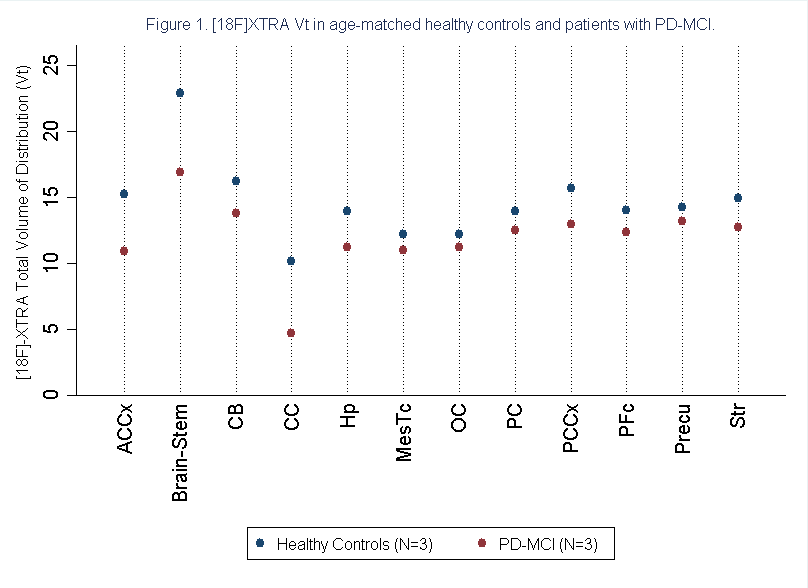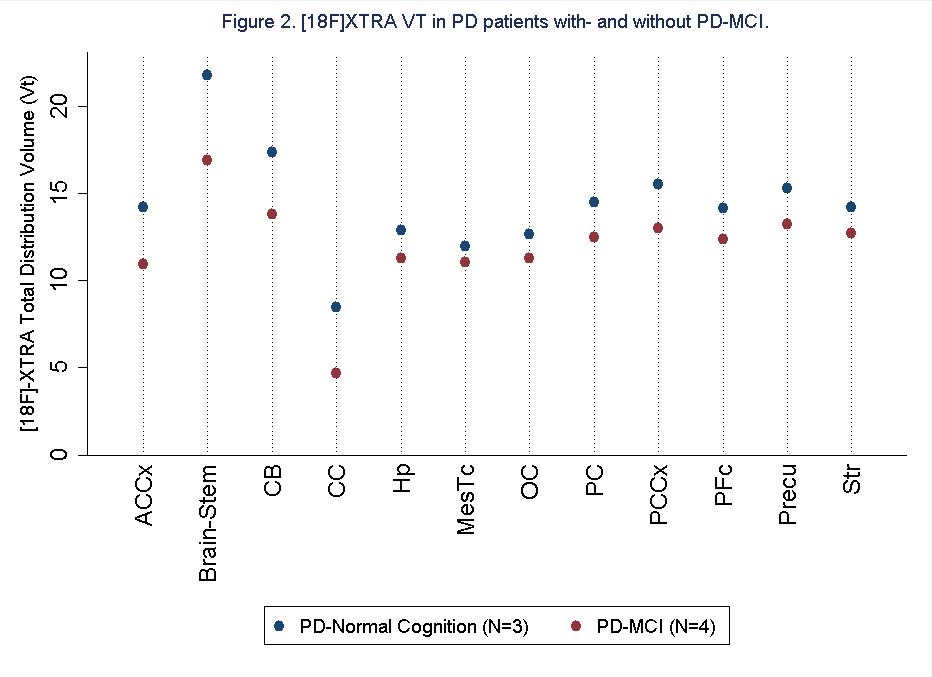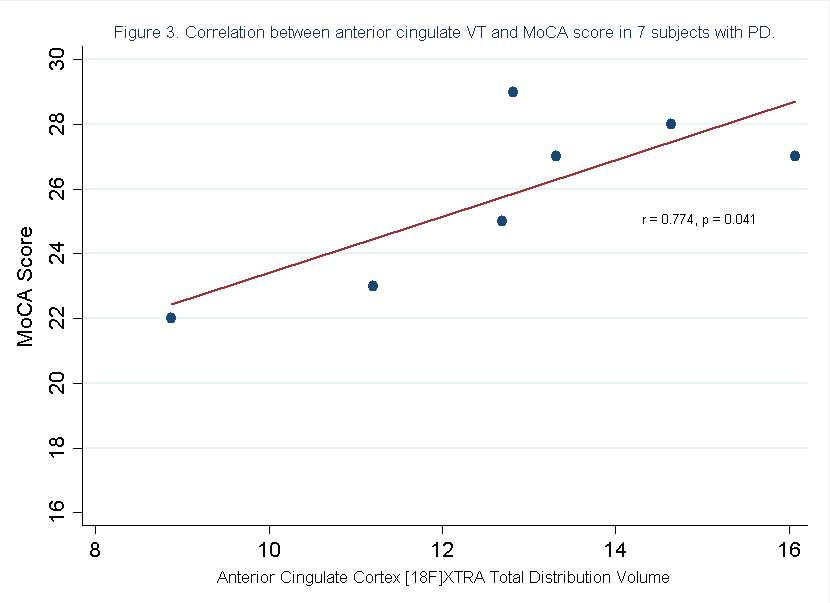Session Information
Date: Monday, October 8, 2018
Session Title: Parkinson's Disease: Neuroimaging And Neurophysiology
Session Time: 1:15pm-2:45pm
Location: Hall 3FG
Objective: We aimed to show that a radiotracer with high affinity to cortical and hippocampal α4β2-nicotinic cholinergic receptors (1) would be reduced in regions associated with PD-related cognitive deficits in PD patients compared with age- and gender-matched controls.
Background: The neurobiology of cognitive impairment in Parkinson disease (PD) is multifactorial, but there is substantial evidence for a role of disordered cholinergic signaling at nicotinic receptors. Elucidating the role of nicotinic cholinergic signaling in PD has been challenging due to the relatively low affinity of the available radiotracers for imaging of cortical regions involved in cognition (2).
Methods: Seven subjects with PD (Hoehn & Yahr range 2.5-3, mean age 6.85 years) with mild cognitive impairment (PD-MCI level I criteria) or normal cognition underwent cognitive assessment with Montreal Cognitive Assessment (MoCA) and then a 150 minute PET scan on the High Resolution Research Tomograph after injection of 3.70e+8 Bq (10 mCi) of [18F]XTRA, at least 12 ours “off” PD medications. Tracer kinetic modeling used the Logan graphical method with metabolite-corrected arterial input function to calculate regional total distribution volumes (VT) of cortical and hipplocampal ROI’s. These data were compared to those from three age-matched healthy controls (HCs) without MCI or Parkinson’s disease.
Results: Vt tended to be lower in PD-MCI patients compared to HCs or PD-normal cognition (PD-NC). When comparing PD-MCI patients and HCs, [18F]XTRA Vt was lower by 19.4% in the hippocampus, 28.5% in the anterior cingulate, and 17.4% in the posterior cingulate [figure 1] without statistical significance. The anterior cingulate Vt was significantly lower in PD-MCI patients compared with PD-NC patients (23.2%, p=0.048), while the hippocampus, anterior and posterior cingulate, parietal cortex, and precuneus tended to be lower in the PD-MCI group as well (12.5%, 23.2%, 16.1%, 13.3%, and 13.7%, respectively [figure 2]). Among patients with PD, the strongest ROI-cognition correlation was between the MoCA and Vt in the anterior cingulate (r=0.7739, p=0.041, [figure 3]).
Conclusions: As a measure of cortical and hippocampal (extrathalamic) α4β2-nicotinic receptor availability, these preliminary data support further studies of [18F]XTRA as a possible marker of cognitive impairment in PD.
References: 1. Meyer PM, Strecker K, Kendziorra K, et al. Reduced alpha4beta2*-nicotinic acetylcholine receptor binding and its relationship to mild cognitive and depressive symptoms in Parkinson disease. Arch Gen Psychiatry 2009;66:866-877. 2. Kuwabara H, Gao Y, Stabin M, et al. Imaging alpha4beta2 Nicotinic Acetylcholine Receptors (nAChRs) in Baboons with [18F]XTRA, a Radioligand with Improved Specific Binding in Extra-Thalamic Regions. Molecular imaging and biology : MIB : the official publication of the Academy of Molecular Imaging 2017;19:280-288.
To cite this abstract in AMA style:
K. Mills, Y. Du, J. Coughlin, A. Horti, M. Pomper, G. Smith. α4β2-nicotinic receptor availability in Parkinson’s disease MCI and healthy controls: A pilot imaging study using [18F]-XTRA PET [abstract]. Mov Disord. 2018; 33 (suppl 2). https://www.mdsabstracts.org/abstract/%ce%b14%ce%b22-nicotinic-receptor-availability-in-parkinsons-disease-mci-and-healthy-controls-a-pilot-imaging-study-using-18f-xtra-pet/. Accessed December 24, 2025.« Back to 2018 International Congress
MDS Abstracts - https://www.mdsabstracts.org/abstract/%ce%b14%ce%b22-nicotinic-receptor-availability-in-parkinsons-disease-mci-and-healthy-controls-a-pilot-imaging-study-using-18f-xtra-pet/



